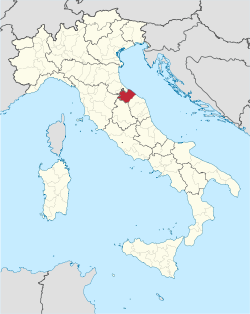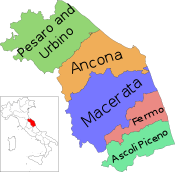Province of Pesaro and Urbino
 From Wikipedia - Reading time: 8 min
From Wikipedia - Reading time: 8 min
Province of Pesaro and Urbino
Provincia di Pesaro e Urbino (Italian) | |
|---|---|
 Rocca of Mondavio | |
 Map highlighting the location of the province of Pesaro e Urbino in Italy | |
| Country | |
| Region | Marche |
| Capital(s) | Pesaro |
| Comuni | 60 |
| Government | |
| • President | Giuseppe Paolini (PD) |
| Area | |
• Total | 2,567.78 km2 (991.43 sq mi) |
| Population (31 January 2022) | |
• Total | 349,507 |
| • Density | 140/km2 (350/sq mi) |
| GDP | |
| • Total | €9.314 billion (2015) |
| • Per capita | €25,697 (2015) |
| Time zone | UTC+1 (CET) |
| • Summer (DST) | UTC+2 (CEST) |
| Telephone prefix | 0721 Pesaro 0722 Urbino |
| Vehicle registration | PU |
| ISTAT | 041 |
| Website | www |


The province of Pesaro and Urbino (Italian: provincia di Pesaro e Urbino, Italian: [proˈvintʃa di ˈpeːzaro e urˈbiːno]) is a province in the Marche region of Italy. Its capital is the city of Pesaro. It also borders the state of San Marino. The province is surrounded by San Marino and Emilia Romagna in the north, Umbria and Tuscany in the west, Ancona in the south and the Adriatic Sea on the east.[2] The province has an enclave of the Umbrian commune of Citta' di Castello named Monte Ruperto. The province is also known as "Riviera of Hills". It is mostly covered by hills and is popular for its beaches.
The ceramics museum and the Biblioteca Oliveriana are located in the capital city.[3]
It has a robust economy with low unemployment, based on small and medium enterprises active in manufacturing, agriculture, tourism, other services. It has a very low per capita energy consumption. The small manufacturing industry contributes 22% of the province's GDP.[4] Tourism in the province plays a primary role in the local economy; the main attractions are the coast and the Apennines. The beaches of Gabicce Mare, Pesaro, Fano and Marotta are the most famous ones.[5] The Lucus Pisaurensis, the Sacred Grove of Pisaurum, ancient Pesaro, is just outside modern Pesaro in the hamlet of Santa Veneranda.
History
[edit]Early sources indicate a pre-Estruscan settlement in Pesaro. The city was established as Pisaurum[6] by the Romans in 184 BC as a colony of the Picentes, an early Italic people who lived on the northeast coast of Italy during the Iron Age.[7] In 1737, 13 ancient votive stones were unearthed in a local Pesaro farm field, each bearing the inscription of a Roman god; these were written in a pre-Estrucan script, indicating a much earlier occupation of the area[8] than the 184 BC Picentes colony. After the fall of the Western Roman Empire, the area was absorbed in the Exarchate of Ravenna. In late mediaval times and early Renaissance it was the center of the county of Urbino, and later, the Duchy of Montefeltro. Later it was part of the Papal States and, from the late 19th century, of the Kingdom of Italy.[citation needed]
After the referendum of 2006, seven municipalities of Montefeltro were detached from the Province to join the Province of Rimini (Emilia-Romagna) on 15 August 2009.[9][10] The municipalities are Casteldelci, Maiolo, Novafeltria, Pennabilli, San Leo, Sant'Agata Feltria and Talamello.
On 17 June 2021, the municipalities of Montecopiolo and Sassofeltrio were transferred from the Province of Pesaro and Urbino to the Province of Rimini.[11]
Comuni
[edit]There are 59 comuni (sg.: comune) in the province.[2]
As of May 31, 2005, the main comuni (municipalities) by population are:
| Commune | Population |
|---|---|
| Pesaro | 94,875 |
| Fano | 61,003 |
| Vallefoglia | 15,029 |
| Urbino | 14,687 |
| Mondolfo | 14,268 |
References
[edit]- ^ Regions and Cities > Regional Statistics > Regional Economy > Regional Gross Domestic Product (Small regions TL3), OECD.Stats. Accessed on 16 November 2018.
- ^ a b Roy Palmer Domenico (2002). The Regions of Italy: A Reference Guide to History and Culture. Greenwood Publishing Group. p. 217. ISBN 978-0-313-30733-1.
- ^ "Pesaro and Urbino". Italia. Retrieved 19 September 2014.
- ^ "Economy and Statistics" (PDF). Circumlavorando (in Italian). Retrieved 19 September 2014.
- ^ "Pesaro e Ancona le sole province marchigiane al 100% balneabili" [Pesaro and Ancona province of the Marche sun bathing at 100%]. Il Resto del Carlino (in Italian). 24 June 2010. Retrieved 19 September 2014.
- ^ Etymology: "Pesaro, which, according to Servius (4th century), derives from the Latin verb "pensare" (= weigh) with reference to the “cursed gold”, with which the Romans paid Brenno, in order that he raised the siege of Rome and then recovered by Marcus Furius Camillus (446 – 365 BC), who "weighed" it. For this reason, Pesaro, according to an established tradition, was called "Pensaurum" (from "pensum" = weight)", italythisway.com. Accessed 22 March 2024.
- ^ Giacomo Devoto, Gli antichi Italici (The ancient Italians), Firenze, Vallecchi, 1931.
- ^ History of Pesaro, italythisway.com. Accessed 22 March 2024.
- ^ (in Italian) Article about the legislation Archived 2011-07-22 at the Wayback Machine
- ^ (in Italian) Article on "il Resto del Carlino"
- ^ "Legge 28 maggio 2021, n. 84" [Law of 28 May 2021, no. 84]. Gazzetta Ufficiale (in Italian). 28 May 2021. Retrieved 2 January 2024.
External links
[edit] Pesaro and Urbino (province) travel guide from Wikivoyage
Pesaro and Urbino (province) travel guide from Wikivoyage- History of Pesaro, Italy, italythisway.com. Accessed 22 March 2024.
 This article incorporates text from a publication now in the public domain: Herbermann, Charles, ed. (1913). "Fossombrone (Forum Sempronii)". Catholic Encyclopedia. New York: Robert Appleton Company.
This article incorporates text from a publication now in the public domain: Herbermann, Charles, ed. (1913). "Fossombrone (Forum Sempronii)". Catholic Encyclopedia. New York: Robert Appleton Company.
 KSF
KSF

